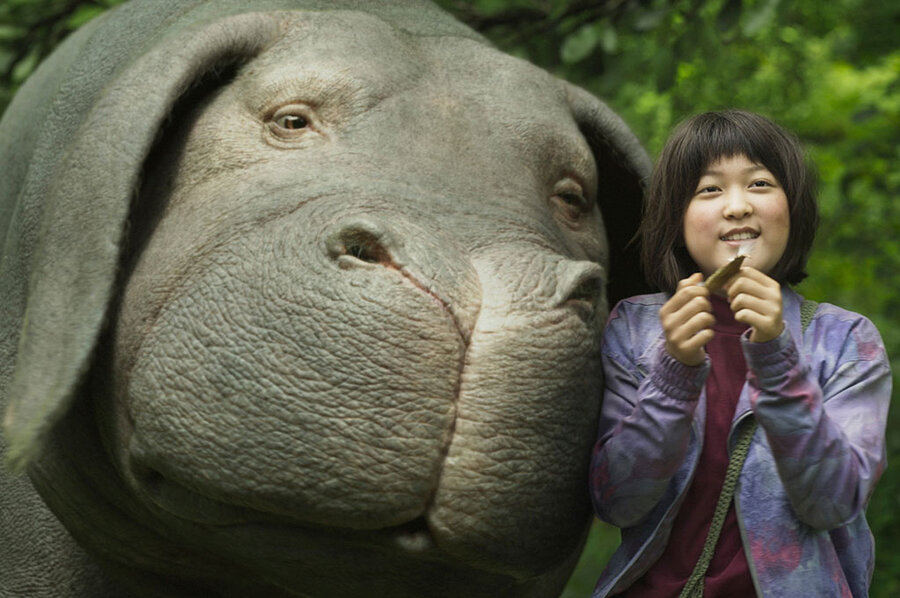'Okja' is a muddled parable that mashes together many genres
Loading...
“Okja” is a nutty, awkward, oddly impassioned parable that mashes together so many different genres that calling it “unclassifiable” doesn’t really explain very much. South Korean director Bong Joon-ho is best known for his socially conscious sci-fi movies – “The Host,” in which a polluted river gives rise to a monster, and “Snowpiercer,” a dystopian thriller pegged to climate change. In “Okja,” he takes aim at the genetically modified organism industry and the meat-eaters among us.
The film – which was shot in two languages and in three countries, and which launches June 28 on Netflix as well as simultaneously in selected theaters – is a species of screed; it plays like a cross between a children’s fable and an apocalyptic action movie. Mija (An Seo-hyun) is a 14-year-old orphan living with her grandfather on a remote mountainside. For 10 years, they have been the designated caretakers of a six-ton “superpig” named Okja, a genetically modified species developed by the New York-based Mirando Corporation. Mirando, headed by its chilly chief executive, Lucy (Tilda Swinton), used to manufacture nerve gas. The superpig enterprise is intended to rebrand the company as the provider of a new eco-friendly food that will feed the world. In addition to Okja, 25 other piglets were farmed out to 25 other far-flung families with the intention, in 10 years, of retrieving and harvesting the best of breed.
Mija, unlike her mercenary grandfather, was kept in the dark about Mirando’s machinations. When the company’s corporate shill, the Steve Irwin-like zoologist Dr. Johnny Wilcox (Jake Gyllenhaal), smuggles Okja to Seoul, South Korea, en route to New York for the big unveiling, to be followed by breeding and execution, Mija chases after them. She is unexpectedly aided by a ragtag guerrilla group called the Animal Liberation Front, headed by its spacey activist, Jay (Paul Dano).
The best parts of the movie are also the least wacky. The early, pre-abduction scenes between Mija and Okja have the kind of childlike entrancement that Steven Spielberg brought to “E.T.,” a movie Bong clearly references here, along with “Babe” and “Pete’s Dragon.” Okja is mostly a CGI creation – CGI meets GMO! – and resembles a bulbous hippo more than a giant pig. I’m grateful Bong and his co-writer, Jon Ronson, did not see fit to give Okja the power of speech. She remains resolutely mute, except for her purrs when Mija naps on her belly, or her wails and whines when the girl almost falls off a cliff and has to be rescued by her.
These bonding scenes are necessary because they set the stage for Mija’s furious, take-no-prisoners pursuit of her beloved pet. I was half hoping the entire movie would be keyed in this idyllic mode, but then I remembered that this is a Bong Joon-ho movie: For him, poetic pastoralism is just a teaser – a way station to something scabrous and wacko.
Stylistically, if not thematically, the early Mija-Okja scenes are almost completely at odds with the rest of the movie. It’s as if “E.T.” got cross-wired with Terry Gilliam’s “Brazil.” Gyllenhaal plays the zoologist as a screechy nut brain who seemingly resides in another galaxy altogether. Swinton plays dual roles. As Lucy, with her corn-silk bangs and alabaster complexion and braces on her teeth, she looks genetically modified herself. As Lucy’s rival and twin sister, Nancy, she’s as severe as Lucy is screw-loose.
If Bong, as he has indicated in interviews, set out to indict not only the GMO industry but also the meat industry, then “Okja” is a muddled parable indeed, since the animal welfare marauders are as daffy as their targets. (One of them is so freaked out by his carbon footprint that he refuses to eat anything at all.) The darkly lit, somber slaughterhouse scenes, in which Mija infiltrates the carnage to rescue Okja, are genuinely disturbing, and yet the point is made repeatedly that these GMO superpigs are “supertasty.” Despite the film’s political protestations, the message here seems to be this: Don’t eat your pets. Grade: B- (This movie is not rated.)







